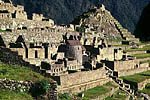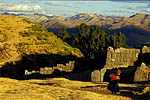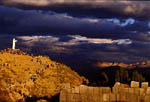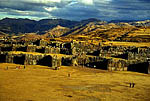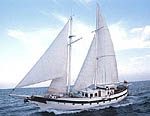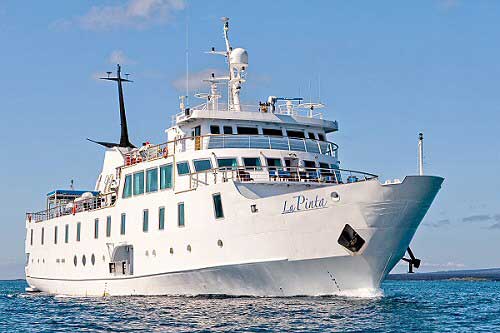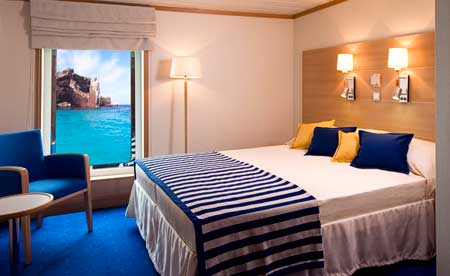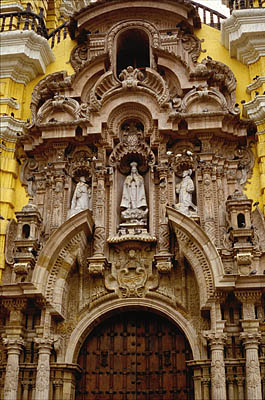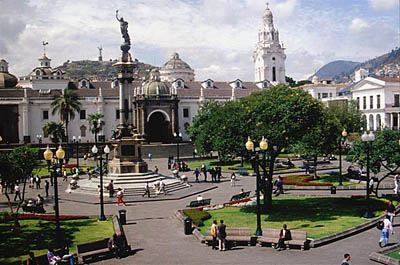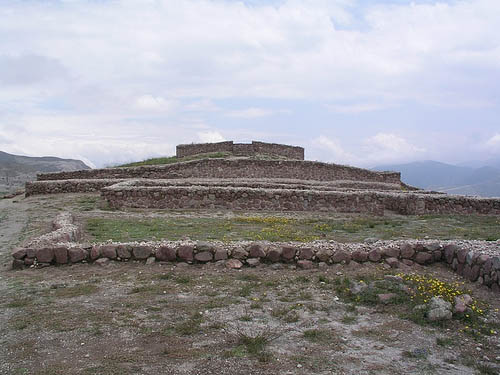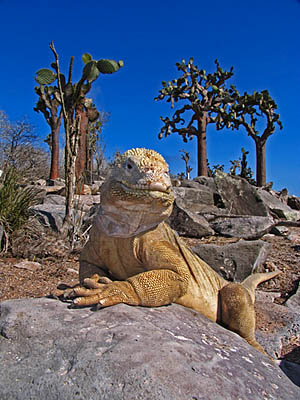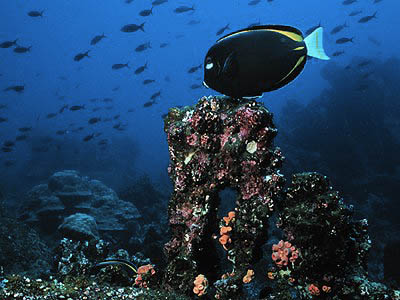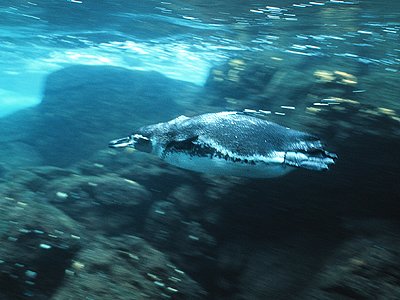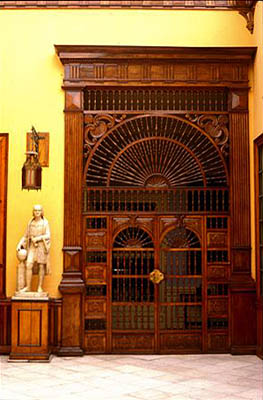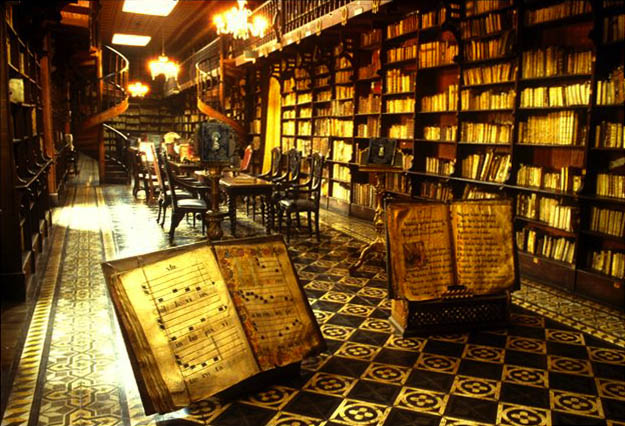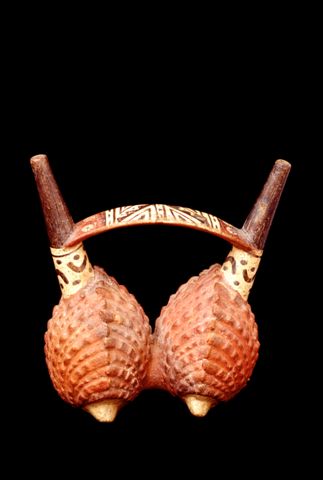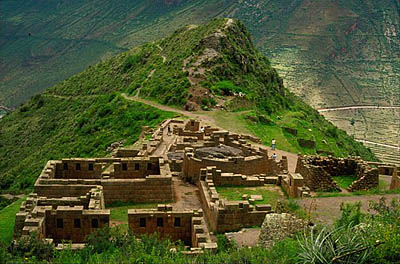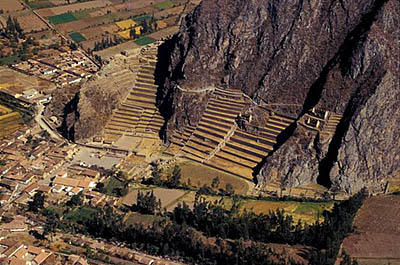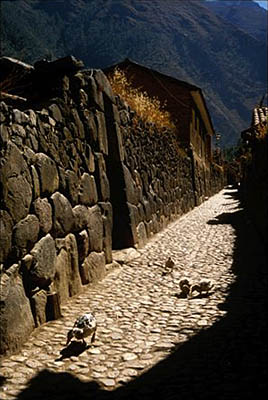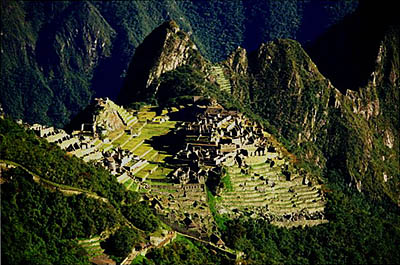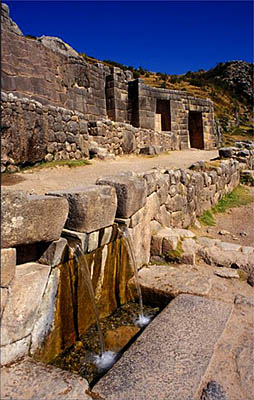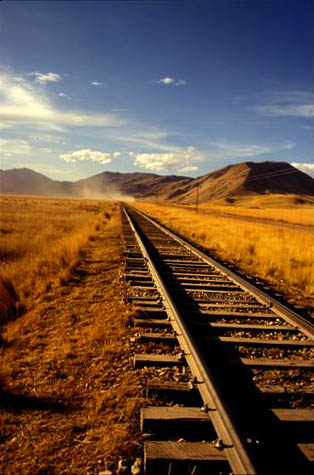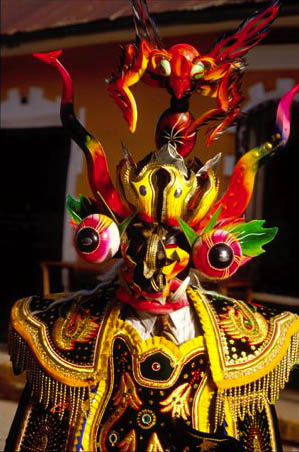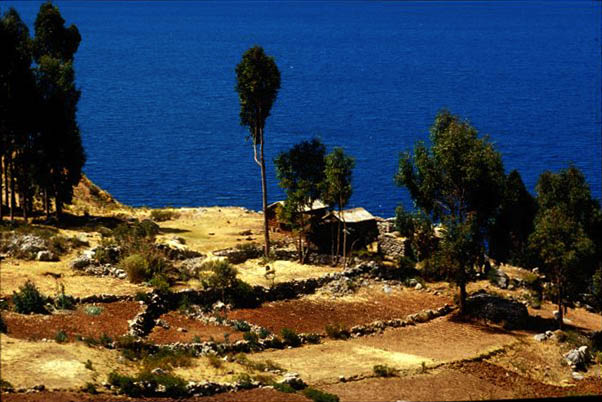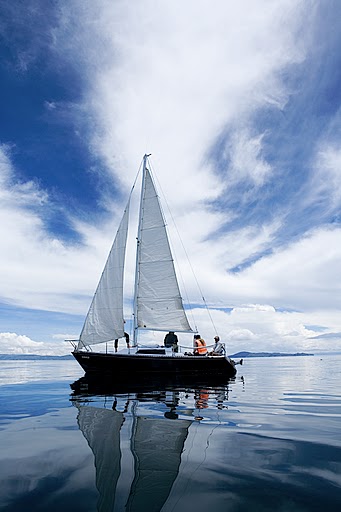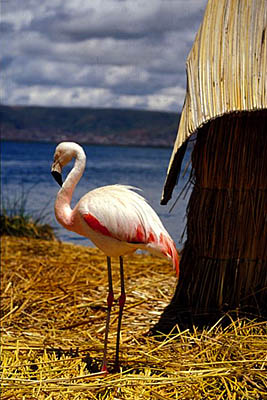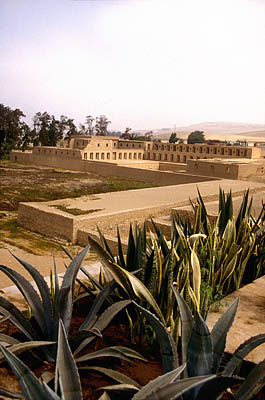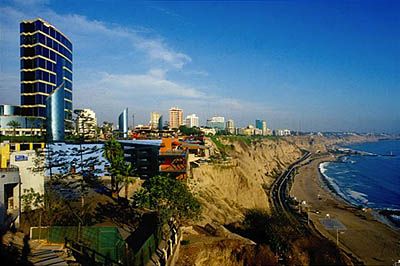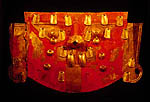![]()
Machu Picchu Tours & Galapagos Cruises
Legacy of the Incas
Machu Picchu Tours & Galapagos Cruises
Peru:
Machu Picchu - Lake Titicaca
(11 days/10 nights)
Machu Picchu Tours & Galapagos Cruises
Peru:
Machu Picchu - Lake Titicaca
(12 days/11 nights)
Empire of the Sun
Machu Picchu Tours & Galapagos Cruises
Peru:
Machu Picchu - Lake Titicaca
(14 days/13 nights)
Ancient Civilizations of Peru
Machu Picchu Tours & Galapagos Cruises
Peru:
Colca Canyon - Machu Picchu
Lake Titicaca
(16 days/15 nights)
Archaeological & Ecological
Treasures
Machu Picchu Tours & Galapagos Cruises
Peru & Ecuador:
Galapagos - Machu Picchu
Lake Titicaca (or Amazon)
(18 days/17 nights)
Grand Tour of the Inca Empire
Machu Picchu Tours & Galapagos Cruises
Peru:
Colca Canyon - Amazon
Machu Picchu- Lake Titicaca
(22 days/21 nights)
Ancient & Colonial Capitals
Machu Picchu Tours & Galapagos Cruises
Peru:
Machu Picchu
(10 days/9 nights)
Inca Trail to Machu Picchu
Machu Picchu Tours & Galapagos Cruises
Peru:
Machu Picchu
(13 days/12 nights)
Machu Picchu & Galapagos
Machu Picchu Tours & Galapagos Cruises
Peru & Ecuador:
Machu Picchu - Galapagos
(15 days/14 nights)
Galapagos & Machu Picchus
Machu Picchu Tours & Galapagos Cruises
Ecuador & Peru:
Galapagos - Machu Picchu
(18 days/17 nights)
Enchanted Isles of the Galapagos
Machu Picchu Tours & Galapagos Cruises
Ecuador:
Galapagos
(11 days/10 nights)
Galapagos & the Kingdom of Quito
Machu Picchu Tours & Galapagos Cruises
Ecuador:
Galapagos - Andes
(16 days/15 nights)
Galapagos & the Amazon
Machu Picchu Tours & Galapagos Cruises
Ecuador:
Galapagos - Amazon
(16 days/15 nights)
Historic Haciendas of the Andes
Machu Picchu Tours & Galapagos Cruises
Ecuador:
Cotopaxi - Antisana - Otavalo
(7 days/6 nights)
© 2013 Inka's Empire Corporation.
All rights reserved.
![]()
Quito - Galapagos - Lima - Sacred Valley - Machu Picchu - Cuzco - Lake Titicaca
Machu Picchu Tours & Galapagos Cruises
Boatman, Uros Islands, Lake Titicaca.
Photo: Mylene d'Auriol Stoessel. Machu Picchu Tours & Galapagos Cruises.
Travel back to ancient empires and the origins of nature...
-- Kimberly Fay, LuxuryLink.com
Land & Cruise Price (18 days/17 nights)
De Luxe US$ 16,245 per person
The prices shown include a Superior Suite aboard the luxurious yacht La Pinta. Our tours also are available with other yachts or with a 7-night Galapagos cruise, instead of 4 nights. Please select a yacht to view details about each vessel and its itinerary.
When considering a Galapagos cruise, note that the islands are distinct in their flora and fauna. Certain islands provide a greater or unique opportunity for observing certain species. Thus, landings on more islands reveal more species and, importantly, the amazingly different adaptations each species has made to its own insular world. Accordingly, a 7-night cruise is preferable. It also offers a greater choice of luxury vessels.
The land and cruise price includes escorted transfers, private excursions with professional guides and chauffeurs on the mainland and semi-private excursions with a certified naturalist on the Galapagos Islands, entrance fees, selected category of accommodations, gourmet cuisine, all land and water transportation, and travel insurance for guests through the age of 59 years (over that age, there is a supplementary fee). All prices are per person based on two people sharing a guest room. For a detailed description of our services, see Opulent Itineraries.
Intra-Tour Flights & Fares
Air fares are in addition to the land and cruise price.
Quito - Galapagos - Guayaquil, Guayaquil - Lima, Lima - Cuzco & Juliaca - Lima: US$ 1,665 per person
Select a Yacht
Luxury Galapagos Cruises
Cormorant
Evolution
Grace
Isabela II
Ocean Spray
Pinta
La Pinta, Galapagos Islands.
Photo: La Pinta. Luxury Galapagos Cruises.
From its roots in southern Peru to its glory in the imperial city of Cuzco, you will experience the panoramic history of the Inca Empire and of the civilizations that inspired the Incas to greatness. Archaeology, art, architecture, folklore and cuisine compose a cultural adventure to forever cherish. If you prefer, choose the Amazon Rainforest, instead of Lake Titicaca. As a prelude to discovering the Empire's archaeological treasures, you will explore one of its greatest ecological treasures on a cruise of the Galapagos Islands.
Upon arrival in Quito, you will be escorted to the palatial Casa Gangotena, then dine on fusion cuisine at Zazu. In Ecuador's capital, founded in 1534, walk along the cobblestone streets through centuries-old parks and plazas to churches filled with gold. Contemplate Gothic, Baroque, Moorish and Neo-Classical architecture, all blended with the mestizo sentiment, and imagine you've gone back in time to the astonishing colonial world. In the evening, take a horse-drawn carriage past the beautifully illuminated facades of the Spanish monuments, and savor vanguard Mediterranean cuisine at Theatrum.
A flight the next morning takes you from the peaks of the Andes to the Galapagos Islands. While yachting this extraordinary archipelago with a naturalist, go ashore amid volcanic landscapes, hike among Marine Iguanas and lava lizards, and have the rare opportunity of snorkeling among penguins and marine tortoises. On these enchanted isles, each with its unique wildlife, you can compare the adaptations of the species to their differing environments that inspired Charles Darwin's theory of evolution.
Cabin, La Pinta, Galapagos Islands.
Photo: La Pinta. Luxury Galapagos Cruises.
From the Galapagos, fly to Lima, a five-century-old Spanish colonial city and home to the country's major museums. The next morning, enter the historic district's crown jewels. In the afternoon, discover the treasures of the Incas at the Museo Larco.
A morning flight into the Andes takes you to Cuzco, the ancient capital, where you will have one day to explore its Inca and colonial monuments, two days in the "Lost City" of Machu Picchu, with a chance to hike a part of the Inca Trail, and two days for the reknowned archaeological sites and native markets of the Sacred Valley of the Incas.
After a spectacular rail adventure on the Orient-Express Andean Explorer through magnificent mountains towering over the deep valleys of the meandering Huatanay River, and across the gentle, rolling Altiplano, where vicuña and alpaca are often seen; your tour will continue on and around Lake Titicaca. Cruise to traditional Taquile Island and the floating Islands of the Uros, and drive to the millennia-old pilgrimage site of Inka Anatawi and the enigmatic archaeological site of Sillustani.
Return to Lima to explore the Pachacamac archaeological site. After a lunch of artistic cuisine by chef Rafael Osterling, walk in the artists' quarter of Barranco, have a farewell drink and transfer to the airport for your overnight flight home, completing your tour of the archaeological and ecological treasures of the Inca empire.
What Luxury Link has to say about Archaeological & Ecological Treasures.
What You Could Add: Galapagos Safari Camp.
Facade, La Iglesia y Convento de San Francisco, Lima.
Photo: Mylene d'Auriol Stoessel. Machu Picchu Tours & Galapagos Cruises.
Highlights
Quito
Day 1: Flight to Quito, Ecuador. International arrival in the afternoon or evening, reception and transfer to your hotel. Dine at Zazu. Overnight in the Casa Gangotena.
Day 2: Quito. This morning, drive to the top of El Panecillo. Its summit overlooks Old Quito. Begin your walking tour of the colonial quarter, highlighted by La Plaza de la Independencia, the Cathedral, La Compañia de Jesús, La Iglesia de San Francisco and La Iglesia y Convento de la Merced. At the City Museum, see what daily life was like in colonial Quito.
Lunch at El Crater, inside the crater of the Pululahua Volcano. Our afternoon destination is Rumicucho, a late 15th century Inca fortress, observatory and temple of the sun. It was built near the equator, which the Incas called Intiñan (Path of the Sun). Before returning to Quito, go to the equator, where you can stand with one foot in the southern hemisphere and the other in the northern hemisphere.
As an alternative, you may choose an afternoon excursion to the Central Bank Museum.
This afternoon, a lunch at Café Tianguez. To complete your insight into the country's archaeology, history and cultures; investigate Ecuador's ancient past in the galleries of the Central Bank Museum.
This evening, return to El Panecillo for a panorama of the beautifully illuminated colonial quarter. Though not of colonial vintage, the neo-Gothic La Basílica is the place to see bizarre and fascinating gargoyles. Admire the night view of the Spanish monuments along Calle de las Siete Cruces, on the way to La Plaza de la Independencia, where you will board a horse-drawn carriage for a romantic ride through the narrow streets of Old Quito. Arrive at Theatrum to savor vanguard Mediterranean cuisine. Afterward, return to your hotel. Overnight in the Casa Gangotena.
Galapagos
Day 3: Quito - Galapagos Cruise. Transfer to the airport. Flight to the Galapagos. Entrance into the National Park, reception and transfer to your yacht. Afternoon island landing and excursion with a naturalist. Back on board. Guides' briefing on the next day's activities. Overnight on La Pinta.
Days 4, 5 & 6: Galapagos Cruise. Morning and afternoon island landings and excursions with a naturalist. Back on board. Guides' briefing on the next day's activities. Overnight on La Pinta.
Lima
Day 7: Galapagos Cruise - Lima. Morning island landing and excursion with a naturalist. Transfer to the airport. Flight to Guayaquil and connection to Lima. Reception and transfer to your hotel. Dinner at the Mesa 18. Overnight in the Orient-Express Miraflores Park.
Day 8: Lima. Morning walking tour in the colonial quarter, visiting the Plaza de Armas and entering La Casa de Aliaga and La Iglesia y Convento de San Francisco. View the exterior of La Iglesia y Convento de Santo Domingo, Lima's oldest convent, and enter La Catedral for a short visit. In contrast to the religious structures, the Torre Tagle Palace is the city's best surviving example of secular colonial architecture. Lunch at the Café del Museo. Afternoon at the Museo Larco. Dine at Astrid & Gastón, one of the highest notes in the Peruvian culinary scene. Overnight in the Orient-Express Miraflores Park.
Sacred Valley
Day 9: Lima - Cuzco - Sacred Valley (Chinchero). Transfer to the airport. Flight to Cuzco. Reception and drive to the Sacred Valley of the Incas. Visit to the Chinchero market and church. Private weaving demonstration. Continue to the Moray archaeological site and the ancient salt pans of Maras. Chef-prepared picnic lunch. If you like, walk down rural paths to the Urubamba River. Arrival at your hotel. At a nearby hacienda, an honored shaman will conduct an ancient ceremony still observed by the indigenous people of Peru to obtain health, well-being and luck. After this memorable experience, you will return to your hotel. Dinner and overnight in the Orient-Express Rio Sagrado.
Day 10: Sacred Valley (Pisaq - Ollantaytambo). After a short visit to the Pisaq market, hike in the Pisaq ruins. Lunch at 3 Keros. Tour of the Ollantaytambo ruins. Dinner and overnight in the Orient-Express Rio Sagrado.
Machu Picchu
Day 11: Sacred Valley - Orient-Express Vistadome - Machu Picchu. Transfer to the train station to meet your guide. Vistadome to Machu Picchu. Transfer to the ruins. Day entrance. Buffet luncheon. Private guided tour in the afternoon. Dinner and overnight in the Orient-Express Sanctuary Lodge.
Cuzco
Day 12: Machu Picchu - Orient-Express Vistadome - Cuzco. Entrance into the ruins. Sunrise over Machu Picchu. Morning exploration with your guide or on your own. Lunch in the hotel. Afternoon exploration with your guide or on your own. Transfer to the train station. Vistadome to the Poroy Station, on the outskirts of Cuzco. Reception and transfer to your hotel. Dinner at the Restaurante El Tupay. Overnight in the Orient-Express Monasterio.
Day 13: Cuzco (Inca Monuments). Morning drive to Awana Kancha, where you will see all four species of South American camelid. Proceed to the nearby Inca monuments of Tambomachay, Puka Pukara, Qenqo and Saqsaywaman. Lunch at Pacha Papa before a visit to an artisan's workshop and the Church of San Blas. Afternoon walk to Inca monuments in the colonial quarter, including the Stone of Twelve Angles, Huacaypata (now called the Plaza de Armas and dominated by the Spanish colonial Cathedral), the fine Inca walls of Inti Q'ijllo, Ajlla Wasi (House of the Virgins of the Sun) and Qorikancha (Temple of the Sun). This evening, you will see pre-Inca and Inca art at the Museo de Arte Precolombino, with a dinner of nouvelle Andean cuisine in the courtyard. Overnight in the Orient-Express Monasterio.
Lake Titicaca
Day 14: Cuzco - Orient-Express Andean Explorer - Puno. Transfer to the train station. First Class service on the Orient-Express Andean Explorer to Puno. Three-course lunch followed by coffee in the observation car. Scenic stop at La Raya, the highest point on the route. Reception and transfer to your hotel. Cocktails, dinner and overnight in the Titilaka.
Day 15: Puno (Taquile Island, Sailing & Inka Anatawi). Morning cruise to Taquile Island to see the living culture of the Incas. Ceremonial lunch baked in an adobe oven. An afternoon excursion on a small sailboat with a skilled sailor will let you experience the splendor and spirit of Lake Titicaca, its islands and the Andes. Later, ascend an Inca trail to Inka Anatawi, a millennia-old pilgrimage site with a vast panorama of the lake and nearly all of its islands. Natural rock sculptures enhance the sacred feeling of this sanctuary, which could well be considered the Gothic cathedral of its age. After descending, visit the local community and see colorful textiles made by its weavers. Return to the hotel. Cocktails, dinner and overnight in the Titilaka.
Options:
Instead of sailing and Inka Anatawi, you may select your choice of afternoon excursions offered by Titilaka, such as one to the poetic pueblos of Juli and Pomata, whose churches are jewels of colonial architecture, or to the anciently-carved rockface known as the Puerta de Amaru Muru.
Day 16: Puno (Uros Islands & Sillustani) - Juliaca - Lima. Drive to the Port of Puno for a morning cruise to the floating islands of the Uros. Upon returning to port, begin an overland excursion to Sillustani. Picnic lunch among the ruins. Continue to the Juliaca airport for the Flight to Lima. Arrival, reception and transfer to your hotel. This evening, a dinner of artistic cuisine at Rafael. Overnight in the Orient-Express Miraflores Park.
Lima
Day 17: Lima. Morning drive to Pachacamac, the most reknowned pre-Inca and Inca pilgrimage site of the coast. Upon returning to Lima, lunch at the extraordinary Huaca Pucllana restaurant, which reinterprets the Peruvian Criollo tradition. Afterward, continue to Barranco for visits to one of the country's finest crafts shops, the Museo de Arte Colonial Pedro de Osma, La Puente de los Suspiros and La Iglesia de La Ermita. After arrival back at the hotel, have a farewell drink, order from room service or just rest before the transfer to the airport for your Overnight Flight Home. Relax in the VIP Club while awaiting departure and enjoy a buffet of light fare and beverages, including Peru's famous pisco sour. Day Room in the Orient-Express Miraflores Park.
Home
Day 18: Lima - Home. Flight and arrival home.
Exceptions to the itinerary:
The Galapagos cruise itinerary described and illustrated below is typical but varies by yacht. Therefore, it should be used only as a guide for learning about the different islands and their wildlife.
Details
The 1535 La Iglesia
de San Francisco, Quito, Ecuador.
Photo: David Bate. Machu Picchu Tours & Galapagos Cruises.
Day 1: Flight to Quito, Ecuador
International arrival this afternoon or evening in Quito. Reception and escorted transfer to the palatial Casa Gangotena. Dine at Zazu, where chef Alexander Laud creates a fusion of South American and international cuisine. Overnight in the Casa Gangotena.
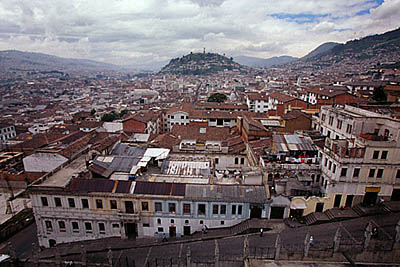
Colonial Quito with
El Panecillo in the distance, Ecuador.
Photo: Dan Heller. Machu Picchu Tours & Galapagos Cruises.
Under the diadem of the Incas, Quito assumed a magnificence which it never saw before and has not displayed since. It was the worthy metropolis of a vast empire stretching from the equator to the desert of Atacama, and walled in by the grandest group of mountains in the world. On this lofty site, which amid the Alps would be buried in an avalanche of snow, but within the tropics enjoys an eternal spring, palaces more beautiful than the Alhambra were erected, glittering with the gold and emerald of the Andes. But all this splendor passed away with the sceptre of Atahuallpa...
-- James Orton, Andes and the Amazon, 1870
Day 2: Quito
Quito has the best-preserved historic district in South America. It is located on an active volcano, 9,300 feet above sea level in the Andes mountains. The city's origins date back to the first millennium, when the Quitu tribe occupied the area and eventually formed a commercial center. The Quitu were conquered by the Caras tribe, who founded the Kingdom of Quito about 980 AD. In 1462, the Incas conquered that kingdom and created a majestic capital for their northern empire. In 1533, Rumiñahui, an Inca war general, razed the city to prevent the Spaniards from taking it, thereby destroying any traces of the prehispanic metropolis. In 1534, the Spanish conquistadores invaded, and Francisco Pizarro founded San Francisco de Quito. Walking along its cobblestone streets through centuries-old parks and plazas to churches filled with gold, you will imagine you've gone back in time to the astonishing colonial world.
Source: Adapted from www.worldheritagesites.org.
La Plaza de la Independencia, Quito, Ecuador.
Photo: Mylene d'Auriol Stoessel. Machu Picchu Tours & Galapagos Cruises.
This morning, drive to the top of El Panecillo. The significance of this hill dates back to Inca times, when it was known as Shungoloma ("hill of the heart") and used as a place to worship the sun. Its summit overlooks Old Quito and is crowned by a winged statue of the Virgin. Begin your walking tour of the colonial quarter at La Plaza de la Independencia, where the country's history was written. On one side is the Cathedral (1640), considered to be the oldest in South America. Down Calle de las Siete Cruces (Street of the Seven Crosses) is La Compañia de Jesús (1605), one of the great baroque masterpieces of the continent. Also in the baroque style is the oldest of South America's colonial churches, La Iglesia de San Francisco (1535). It was constructed over the Inca Palace of Atahualpa and decorated with images of the sun to lure in the native people. The Moorish style of La Iglesia y Convento de la Merced is most likely explained by artists seeking refuge in South America after the expulson of the Moors from Spain. Started in 1538, the church was rebuilt in 1737. At the City Museum, see what daily life was like in colonial Quito.
El Pucará de Rumicucho
Photo: Erythren. Machu Picchu Tours & Galapagos Cruises.
Lunch of Ecuadorian or international cuisine by chef Carlos Alvear at El Crater, inside the Pululahua Volcano. Our afternoon destination is Rumicucho, a late 15th century Inca fortress, observatory and temple of the sun. It was built near the equator, which the Incas called Intiñan (Path of the Sun). Rumicucho was strategically located to allow communication by smoke signals with the ceremonial center of Cochasqui, 9 miles to the east, and with Quito's El Panecillo and the Palace of Atahualpa, 17 miles to the south. Before returning to Quito, go to the equator, where you can stand with one foot in the southern hemisphere and the other in the northern hemisphere. Don't be fooled by the Equatorial Monument, which isn't in the true position.
As an alternative, you may choose an afternoon excursion to the Central Bank Museum.
This afternoon, a lunch of traditional Ecuadorian cuisine by chef Juan José Loaiza at Café Tianguez. To complete your insight into the country's archaeology, history and cultures; investigate Ecuador's ancient past in the pre-Inca, Inca and colonial galleries of the Central Bank Museum. The Incas believed that gold nuggets were the tears of the sun, and one of the galleries, the Golden Court, dazzles the visitor with the gold masks and figurines they fashioned to worship their deity.
Traditional horse-drawn carriage, Quito, Ecuador.
Photo: Hotel Plaza Grande. Machu Picchu Tours & Galapagos Cruises.
This evening, return to El Panecillo for a panorama of the beautifully illuminated colonial quarter. Though not of colonial vintage, the neo-Gothic La Basílica is the place to see bizarre and fascinating gargoyles in the form of giant tortoises, iguanas, anteaters, monkeys, pumas, condors and other Ecuadorian fauna. Admire the night view of the Spanish monuments along Calle de las Siete Cruces, on the way to La Plaza de la Independencia, where you will board a horse-drawn carriage for a romantic ride through the narrow streets of Old Quito. Arrive at Theatrum to savor vanguard Mediterranean cuisine by chef Julio Jose Avendaño Ostolaza. Afterward, return to your hotel. Overnight in the Casa Gangotena.
Land iguana and opuntia cacti, Galapagos Islands.
Photo: Ron Dahlquist. Machu Picchu Tours & Galapagos Cruises.
We seem to be brought somewhat near to that great fact
-- that mystery of mysteries --
the first appearance of new beings on this earth...
The natural history of these islands is eminently curious, and well deserves attention. Most of the organic productions are aboriginal creations, found nowhere else; there is even a difference between the inhabitants of the different islands; yet all show a marked relationship with those of America, though separated from that continent by an open space of ocean, between 500 and 600 miles in width. The archipelago is a little world within itself, or rather a satellite attached to America, whence it has derived a few stray colonists, and has received the general character of its indigenous productions. Considering the small size of the islands, we feel the more astonished at the number of their aboriginal beings, and at their confined range. Seeing every height crowned with its crater, and the boundaries of most of the lava-streams still distinct, we are led to believe that within a period geologically recent the unbroken ocean was here spread out. Hence, both in space and time, we seem to be brought somewhat near to that great fact -- that mystery of mysteries -- the first appearance of new beings on this earth.
-- Charles Darwin, Voyage of the Beagle, 1845
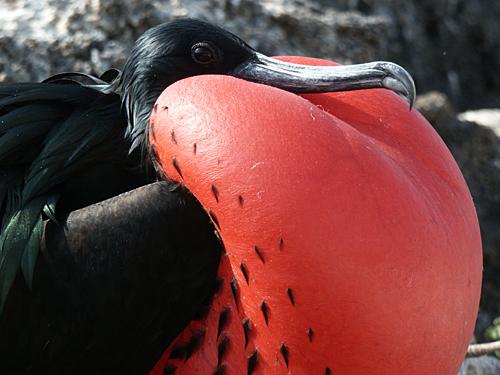
Male frigate bird displaying,
Galapagos Islands.
Photo: Marco Robalino. Machu Picchu Tours & Galapagos Cruises.
From so simple a beginning endless forms most beautiful and most wonderful
have been, and are being evolved...
Thus, from the war of nature, from famine and death, the most exalted object which we are capable of conceiving, namely, the production of higher animals, directly follows. There is grandeur in this view of life, with its several powers, having been originally breathed by the Creator into a few forms or into one; and that, whilst this planet has gone cycling on according to the fixed law of gravity, from so simple a beginning endless forms most beautiful and most wonderful have been, and are being evolved.
-- Charles Darwin, On the Origin of Species by Means of Natural Selection, 1859
Sea turtle, Galapagos Islands.
Photo: Bonnie Pelnar. Machu Picchu Tours & Galapagos Cruises.
Northern Islands
Day 3: Quito - Galapagos Cruise (Baltra Island & Santa Cruz Island)
Breakfast. Early morning transfer to the airport for the flight to Baltra Island (27 sq. km.). The flora on this small island include introduced species of cacti and the native species of palo santo, susevium and mangrove. Fauna include land iguanas, marine iguanas and sea turtles. There are no visitors' sites. Arrival, reception and transfer south to your yacht in Puerto Ayora, on Santa Cruz Island. Briefing on the ship and the Galapagos Islands by your guides and staff of the Galapagos National Park.
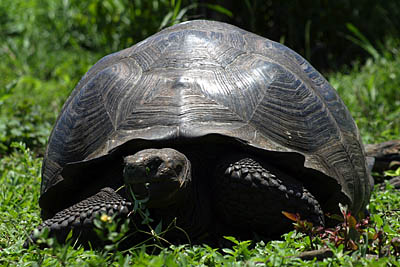
Giant tortoise, Galapagos
Islands.
Photo:
David Bate. Machu Picchu Tours & Galapagos Cruises.
Santa Cruz Island (986 sq. km.) is the second largest in the archipelago and the most populated. Home to the Charles Darwin Research Station, it has many trails, beaches and places for snorkeling. Flora include cacti, saltbrush and mangroves. Fauna include several of the 11 remaining subspecies of giant tortoises, marine iguanas, sharks and various species of waterbirds and landbirds, such as vermillion flycatchers and Darwin's finches. Afternoon excursion to the Santa Cruz Highlands, where you will observe Los Gemelos, twin volcanic craters, and Cerro Chato. Chances are good for sighting the famous giant tortoises that gave these islands their name. Additionally, you can walk inside the dormant lava tubes. Overnight on La Pinta.
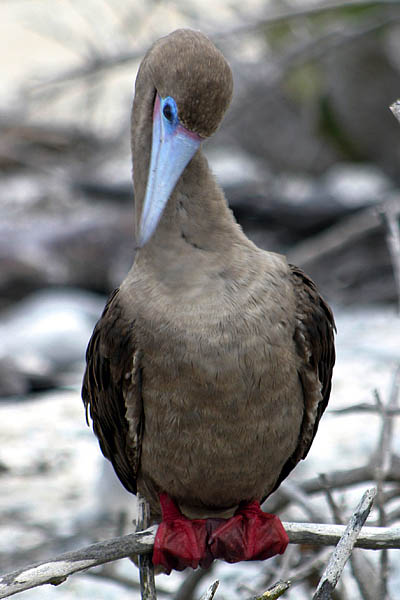
Red-footed booby, Galapagos
Islands.
Photo:
David Bate. Machu Picchu Tours & Galapagos Cruises.
Day 4: Galapagos Cruise (Rabida Island & Santiago Island)
Rabida Island (5 sq. km.) is small with red-hued beaches and volcanic formations. Its color is due to the high content of oxidized iron in the lava. Dry landing at the red beach frequented by sea lions. A short trail leads to a saltwater lagoon, where we will find small colonies of flamingos feeding. The brown pelicans nest in the mangroves found on the far side of the lagoon. Other island fauna include white-cheeked pintail ducks, boobies and nine species of Darwin's finches. A 750-meter trail leads to a volcanic peak covered with aromatic but bare-branched palo santo trees and ends at a great snorkeling spot. Hike, snorkel and ride out in a dingy to the reefs.
Goldrimmed surgeonfish, Galapagos Islands.
Photo: Bonnie Pelnar. Machu Picchu Tours & Galapagos Cruises.
Santiago Island (585 sq. km.) is the fourth largest in the archipelago. The eroded shapes on its black lava shoreline form pools that house a variety of wildlife and are wonderful for snorkeling. Wet landing on the dark-sand beach at Puerto Egas. Most of the landscape is tuff-stone layers and lava flows; the surroundings are prime for observing Darwin's finches, Galapagos doves, Galapagos hawks, hunting herons, great blue herons, lava herons, American oyster catchers and yellow-crowned night herons. You will enjoy the sight of marine iguanas grazing upon algae beds at low tide, sharing space with red Sally light-foot crabs. There is a colony of fur seals swimming in deep pools of cool water, called "grottos". This is an excellent place for swimming and snorkeling in search of octopuses, sea horses, starfishes and other sea life caught in the small tidal pools. In the ocean, you can admire moray eels, hammerhead, white-tip and Galapagos sharks, golden and white-spotted eagle rays, jacks, wahoos, tunas, groupers, red-tailed and dog snappers, sea lions, sea turtles (November to May), black and yellow-black Galapagos corals, sea fans and sponges. Overnight on La Pinta.
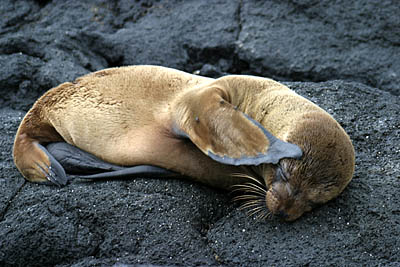
Juvenile seal lion,
Galapagos Islands.
Photo: David Bate. Machu Picchu Tours & Galapagos Cruises.
Day 5: Galapagos Cruise (Fernandina Island & Isabela Island)
Fernandina Island (642 sq. km.) is the third largest, youngest and westernmost in the archipelago. Many eruptions have been recorded since 1813, making Fernandina the island most likely to become volcanically active. After a dry landing at Espinoza Point, you will see the largest colony of marine iguanas in the islands, mingling with Sally light-foot crabs. Other fauna include Galapagos penguins, Galapagos hawks and sea lions. There are also nesting sites of flightless cormorants. These birds have adapted to their environment by perfecting their ability to hunt for food in the ocean -- their wings, tails and feet have evolved for swimming. To see these birds is to witness evolution in action. Among the volcanic formations, observers will note "pa-hoe-hoe", other unusual lava formations and recent lava flows. Flora include brachycereus cacti and mangroves, whose beds extend into the sea, indicating a healthy and thriving ecosystem.
Swimming Galapagos penguin, Galapagos Islands.
Photo: Bonnie Pelnar. Machu Picchu Tours & Galapagos Cruises.
Isabela Island (4,588 sq. km.) is the largest in the archipelago. It is formed by five young, active volcanoes, of which Volcano Wolf is the highest point in the Galapagos (1,707 meters, or 5,599 feet). On a panga ride along the cliffs of Tagus Cove, look for Galapagos penguins and other sea birds before making a wet landing at Urbina Bay. The bay, at the foot of the Alcedo Volcano, was uplifted from the sea in 1954. Flightless cormorants and pelicans nest along the coast, and sea turtles and manta rays can be seen in the bay. The highlands include large and colorful land iguanas. Other fauna include the largest population of giant tortoises (about 4,000 but difficult to spot), Galapagos hawks, magnificent frigate birds, marine iguanas, hammerhead, white-tipped and Galapagos sharks, eels, groupers and snappers. Continue to Punta Vicente Roca for dinghy sightseeing, snorkeling and scuba diving. Enjoy the high cliffs with tuff-stone, ash and other lava formations; caves; nesting sites for brown noddies and blue-footed boobies; and up-close encounters with sea lions, fur seals and the occasional dolphin. Overnight on La Pinta.
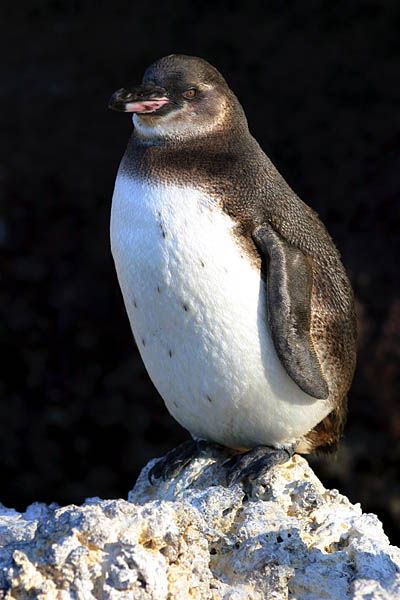
Galapagos penguin, Galapagos
Islands.
Photo:
David Bate. Machu Picchu Tours & Galapagos Cruises.
Day 6: Galapagos Cruise (Bartolome Island & Santa Cruz Island)
Bartolome Island (1.2 sq. km.), small and moonlike, has one of the most famous sights in the archipelago: Pinnacle Rock. After a dry landing, you will see volcanic formations, including lava bombs, spatter and cinder cones. Hike to the summit for an impressive panorama of Sullivan Bay, including the eroded tuff cone of Pinnacle Rock, and the surrounding islands. The exotic flora of red mangroves, tiquilias and cacti all add to the experience. During the ascent, you will see a large colony of marine iguanas and lava lizards. Snorkeling will give you a chance to cool off and see marine fauna, such as Galapagos penguins, nesting sea turtles (January to March) and white-tipped sharks.
Sea turtle, Galapagos
Islands.
Photo:
David Bate. Machu Picchu Tours & Galapagos Cruises.
Santa Cruz Island. On an excursion to Black Turtle Cove, located near Las Bachas Beach in the north of the island, take a panga ride though the mangroves, during which the outboard motor of the small boat is turned off, allowing close observation of sea turtles, white-tipped reef sharks, spotted eagle rays and yellow rays. Overnight on La Pinta.
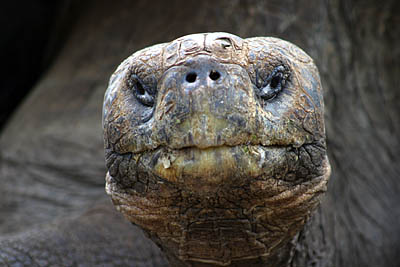
Giant tortoise, Galapagos
Islands.
Photo:
David Bate. Machu Picchu Tours & Galapagos Cruises.
Day 7: Galapagos Cruise (Santa Cruz Island & Baltra Island) - Lima
Morning visit to the Charles Darwin Research Station, staffed with international scientists conducting biological research and conservation projects. Here, you can admire giant tortoises, part of the program to breed, rear and reintroduce different subspecies of tortoises back into their natural habitat. Surrounding the station is an impressive giant prickly-pear cactus forest with many land birds. Afterward, some free time to walk around the town of Puerto Ayora. Transfer to the Baltra Island airport for the flight to Guayaquil and your connection to Lima.
Arrival in the five-century-old colonial city of Lima, "City of the Kings" and the capital of Peru. Reception and escorted transfer to your hotel in the garden district of Miraflores, high above the Pacific Ocean and home to the city's grand 19th century mansions. dinner of vanguard cuisine by resident chef Diego Muñoz at Mesa 18. Overnight in the Orient-Express Miraflores Park.
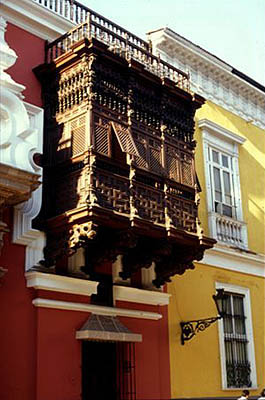
Wooden balcony of the Torre Tagle Palace, Lima.
Photo: Mylene d'Auriol Stoessel. Machu Picchu Tours & Galapagos Cruises.
At ancient Peru's most exalted pilgrimage site, eroded temples speak of the pre-Columbian cultures that worshipped the earth god Pachacamac ("he who gives life to the universe"). When the Incas arrived, they respected the temples and religion of those people, allowing them to worship that god alongside the Incas' own god, the Sun. For their deity, the Incas erected a great stone temple on a cliff above the sea. When the Spaniards arrived, they destroyed the holiest place in their lust for gold but found that the only treasure it contained was spiritual.
Nearby Lima, founded by the conquistador Francisco Pizarro in 1535, came to be the capital of the New World for a period of three hundred years. It reached its grandest splendor in the 17th and 18th centuries. The city has two principal attractions: the colonial quarter, where a visit to La Casa de Aliaga is to go back in time to the earliest years of the Spanish conquest, and the archaeological museums, which display gold, ceramic and textile masterpieces of Peru's pre-Inca and Inca civilizations. The country's independence movement was led by Jose de San Martin of Argentina and Simon Bolivar of Venezuela. San Martin proclaimed Peruvian independence from Spain on July 28, 1821, marking the end of the colonial period and the beginning of the republican era.
Entry door of the Casa Aliaga, Lima.
Photo: Mylene d'Auriol Stoessel. Machu Picchu Tours & Galapagos Cruises.
Day 8: Lima
Breakfast. This morning, walk with your guide in the heart of the city, which preserves its Spanish colonial heritage of the 16th-18th centuries. It was Francisco Pizarro, the founder of Lima, who determined the area for the Plaza de Armas as well as the location of the structures around it. In the center of the plaza is a splendid bronze fountain of 1650. Around the plaza and originally dating back to the city's beginnings in 1535 are the Cathedral, destroyed in the earthquake of 1746 and rebuilt in 1758; the Archbishop's Palace, rebuilt in 1924; and the Presidential Palace, rebuilt in 1937. Surviving intact is La Casa de Aliaga. Built in 1535 by Don Jeronimo de Aliaga, a member of Pizarro's conquering forces and co-founder of the city, it is still inhabited by the original family. Your visit to this antique-filled mansion is to go back in time to the earliest years of the Spanish conquest of Peru.
17th century library, La Iglesia y Convento de San Francisco, Lima.
Photo: Mylene d'Auriol Stoessel. Machu Picchu Tours & Galapagos Cruises.
On your walking tour, enter the 1674 La Iglesia y Convento de San Francisco, the most spectacular of Lima's colonial-era churches. It features cloisters and interiors of Spanish tiles; Moorish-style, carved-wood ceilings; a fine museum of religious art; a 17th century library of twenty-thousand books, many dating from the first years of the city's founding; and catacombs begun in 1546. View the exterior of the 1599 La Iglesia y Convento de Santo Domingo, Lima's oldest convent, and enter the 1758 La Catedral for a short visit. In contrast to the religious structures, the 1735 Torre Tagle Palace, with its gorgeous baroque stone doorway and carved-wood balconies, is the city's best surviving example of secular colonial architecture.
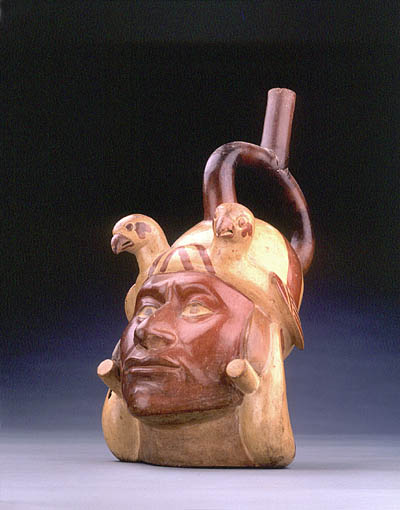
Mochica, 500 AC.
Photo: Museo
Larco, Lima, Peru. Machu Picchu Tours & Galapagos Cruises.
Lunch of traditional Peruvian cuisine at the Café del Museo, located in the gardens of the Museo Larco and directed by Peru's most prestigious chef, Gastón Acurio. Founded in 1926, the Museo Larco exhibits the world's largest private collection of pre-Columbian art -- a treasure trove of gold, silver, semi-precious stones and textiles. The collection's predominant strength is in Mochica ceramics, of which the erotic ones are the most famous. Their notariety ought not to obscure the fact that the museum presents a complete view of the cultural development of ancient Peru through a selection of its 45,000 pieces, housed in a colonial building of the 18th century.
"Huaco" depicting Spondylus shells, Northern Huari culture, c. 800 AD.
Museo Larco, Lima. Photo: Mylene d'Auriol Stoessel. Machu Picchu Tours & Galapagos Cruises.
Return to your hotel to relax. This evening, dine at Astrid & Gastón. When the restaurant was founded a decade ago by Gastón Acurio and Astrid Gutsche, the restaurant's cuisine was largely French. Both chefs had studied in Paris' Le Cordon Bleu. Gradually, though, as they rediscovered Peruvian flavors and culinary traditions, the kitchen began to incorporate local dishes and ingredients, moving towards the current sophisticated Criollo concept that characterizes the restaurant today and makes it one of the highest notes in the Peruvian culinary scene. Overnight in the Orient-Express Miraflores Park.
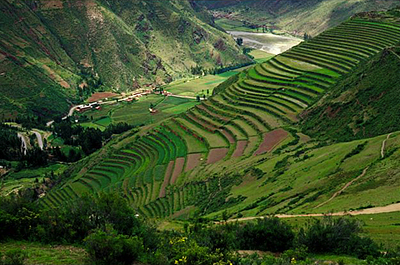
Terraces of Pisaq, Sacred Valley.
Photo: Mylene d'Auriol Stoessel. Machu Picchu Tours & Galapagos Cruises.
But the favorite residence of the Incas was at Yucay, about four leagues distant from the capital. In this delicious valley, locked up within the friendly arms of the sierra, which sheltered it from the rude breezes of the east, and refreshed by gushing fountains and streams of running water, they built the most beautiful of their palaces. Here, when wearied with the dust and toil of the city, they loved to retreat, and solace themselves with the society of their favorite concubines, wandering amidst groves and airy gardens, that shed around their soft, intoxicating odors, and lulled the senses to voluptuous repose. Here, too, they loved to indulge in the luxury of their baths, replenished by streams of crystal water which were conducted through subterraneous silver channels into basins of gold. The spacious gardens were stocked with numerous varieties of plants and flowers that grew without effort in this temperate region of the tropics, while parterres of a more extraordinary kind were planted by their side, glowing with the various forms of vegetable life skilfully imitated in gold and silver! Among them the Indian corn, the most beautiful of American grains, is particularly commemorated, and the curious workmanship is noticed with which the golden ear was half disclosed amidst the broad leaves of silver, and the light tassel of the same material that floated gracefully from its top.
-- William H. Prescott, The History of the Conquest of Peru, 1847
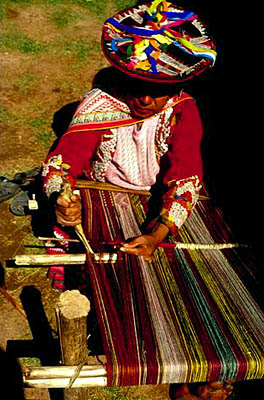
Weaver of Chinchero, Sacred Valley.
Photo: Mylene d'Auriol Stoessel. Machu Picchu Tours & Galapagos Cruises.
Day 9: Lima - Cuzco - Sacred Valley (Chinchero)
Breakfast. Early transfer to the airport for the flight to Cuzco, the capital of the ancient Inca Empire, called Tawantinsuyo. The name of Cuzco is a Spanish version of the native word Q'osqo, which means the "Navel of the Universe". Arrival, reception and drive to the Sacred Valley of the Incas. On the way, visit Chinchero, the birthplace of the rainbow, according to Inca legend. The village is on the altiplano, or highlands, above Cuzco and the Sacred Valley, at an elevation of 12,340 feet, and rises against a superb Andean landscape dominated by eternally snow-capped peaks. This late 15th century agricultural center maintains its Inca traditions, one being its composition of "ayllus", or groups of indigenous, related families that work communally in the cultivation of their fields.
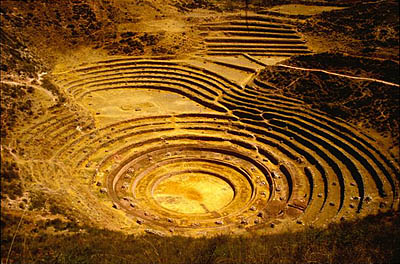
Sunken agricultural terraces of Moray, Sacred Valley.
Photo: Mylene d'Auriol Stoessel. Machu Picchu Tours & Galapagos Cruises.
Traditional weaving is preserved, in part, through the efforts of The Center for Traditional Textiles of Cusco, which has arranged a private demonstration by one of the finest weavers. Another tradition that traces it roots back to the Incas is the barter, or "trueque", market. In Chinchero, people still meet to trade good for goods, just as in ancient times, when money did not exist. The market, noted for its textiles, takes place in the main square, at the foot of an Inca wall. Such traditions are not unique to Chinchero; they still exist throughout the altiplano of Peru. The pueblo exhibits a peculiar Andean-Hispanic architectural style, and paintings by the famous native artist Chiwantito hang in a beautiful colonial church. The canvases are in the Cuzqueña style, dating back to the early Spanish period.

Yucay Church, Sacred Valley.
Photo: Mylene d'Auriol Stoessel. Machu Picchu Tours & Galapagos Cruises.
Afterward, visit the impressive archaeological site of Moray. These circular terraces were built by the Incas in natural sinkholes on a limestone plateau overlooking the Sacred Valley and, according to experts, were used to grow crops in different microclimates. Nearby, below the colonial town of Maras, are age-old, terraced salt mines. At a scenic place along the route, we'll set up a table and chairs for a picnic lunch prepared by chef Tatiana Mendoza of Cuzco. If you like, take a three-quarter-hour walk down rural paths to the Urubamba River, where your driver and car will be waiting. Arrival at your hotel, the gracious Rio Sagrado, on the banks of the Urubamba, the Inca's sacred river.
Traditional healer's ceremony.
Photo: Kerry Chirinos. Machu Picchu Tours & Galapagos Cruises.
At a nearby hacienda, an honored shaman will conduct an ancient ceremony still observed by the indigenous people of Peru. To perform this ritual, the shaman, Hubert Lazarte, gathers such traditional items as coca leaves and wine for a simple offering. Each participant selects three coca leaves and chews them while making wishes for health, well-being and luck, then adds the leaves to the tribute, which includes medicinal and aromatic plants. The shaman prays in the Inca language of Quechua, asking Pacha Mama (Mother Earth) and the Apus (mountain spirits) to grant the wishes as he burns the offering on an altar before burying it in the earth. After this memorable experience, you will return to your hotel. For dinner, executive chef Federico Ziegler presents a delicious fusion of Urubamba’s best kept culinary secrets, Peruvian traditional zest and international delicacies. Dinner and overnight in the Orient-Express Rio Sagrado.
Ruins of Pisaq surrounding the solar calendar, Sacred Valley.
Photo: Mylene d'Auriol Stoessel. Machu Picchu Tours & Galapagos Cruises.
Day 10: Sacred Valley (Pisaq - Ollantaytambo)
Breakfast. Drive through along the Urubamba River to the colonial town of Pisaq, where a popular handicraft fair take place under the main square's century-old tree, with wares displayed on vividly patterned and colored textiles. On Sundays, the traditional mass is held in Quechua, the Inca language, at the local church, which is attended by the village leaders from the surrounding communities. They wear their typical costumes and carry their traditional scepter of authority, or vara, that gives origin to their name of Varayoc.
Girl of Pisaq adorned in traditional attire and cantuta flowers, Sacred Valley.
Photo: Mylene d'Auriol Stoessel. Machu Picchu Tours & Galapagos Cruises.
High on a mountain above, tower the imposing remains of an ancient settlement. The Pisaq ruins take up the entire mountain and are made up of different neighborhoods, or squares, the main one being Intihuatana, which is admired for the architectural skill of its constructions. Its central feature is a monumental solar calendar on a promontory from which there are spectacular outlooks. At the same time, the pre-Hispanic cemetery is of great interest, as it is the largest found in this part of the continent, containing thousands of tombs, some of them looted. Pisaq also is famous for the colossal terraces that circle the mountains and the fabulous watchtowers, which were used as observation points as well as for control and military defense.
Fortress of Ollantaytambo, Sacred Valley.
Photo: Mylene d'Auriol Stoessel. Machu Picchu Tours & Galapagos Cruises.
A lunch of nouvelle Andean cuisine by chef Ricardo Behar at 3 Keros. El Huacatay and 3 Keros fight for the title of the best restaurant in the Sacred Valley. The two restaurants greatly elevate the gastronomic offering of the valley.
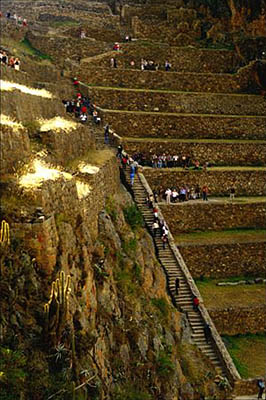
Agricultural terraces, Fortress of Ollantaytambo, Sacred Valley.
Photo: Mylene d'Auriol Stoessel. Machu Picchu Tours & Galapagos Cruises.
Continue to the Ollantaytambo archeological site, a gigantic agricultural, administrative, social, religious and military center in the era of Tawantinsuyo. According to legend, the fortress belonged to a powerful lord, Ollantay, who fell in love with Princess Cusi Coillor, daughter of Inca Pachakuteq. It later served Manco Inca after his defeat by the Spaniards at Saqsaywaman.The architectural style of its streets and squares reflects Inca town planning, with enormous polyhedral stones forming the walls and trapezoidal doorways of temples and palaces set along rectilinear and narrow streets, which have been inhabited continuously since Inca times.
Incan town of Ollantaytambo, Sacred Valley.
Photo: Mylene d'Auriol Stoessel. Machu Picchu Tours & Galapagos Cruises.
Above the town, a mountain rises which houses innumerable Inca constructions, such as magnificently-crafted temples and terraces. One striking construction is the partially-destroyed main temple, believed to be the Temple of the Sun, whose carved-stone facade is made up of six perfectly-sculpted, red monoliths. The mountainside on which this enormous fortress is built is strategic: it dominates three valleys that come together at this point. Across one valley, tremendous blocks of stone lie abandoned along the route from the quarry site to Ollantaytambo, their uncompleted journey marking the arrival of the "Conquistadores". Return to your hotel. Dinner and overnight in the Orient-Express Rio Sagrado.
Citadel of Machu Picchu.
Photo: Mylene d'Auriol Stoessel. Machu Picchu Tours & Galapagos Cruises.
Arrive like the Inca!
Consider an unforgettable arrival on the Royal Inca Trail
(Trek must be requested in writing at the time of booking your tour.)
Photo album: Marvels of Machu Picchu
Day 11: Sacred Valley - Orient-Express Vistadome - Machu Picchu
Breakfast. Early transfer to the station to meet your guide and board the train for a descent into the Urubamba Valley to reach Machu Picchu (Old Peak), the "Lost City of the Incas". The Orient-Express Vistadome's recently renovated carriages have panoramic windows, offering enhanced photographic opportunities. Refreshments will be served. Upon arrival, your guide will accompany you to the Orient-Express Sanctuary Lodge, near the top of Machu Picchu and next to the ruins.
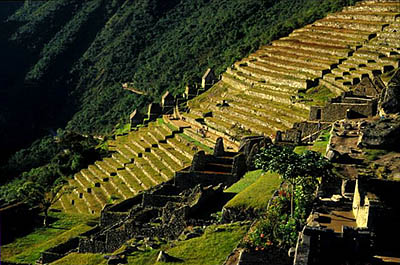
Agricultural terraces,
Machu Picchu.
Photo:
Mylene d'Auriol Stoessel. Machu Picchu Tours & Galapagos Cruises.
A sumptuous buffet luncheon of regional cuisine by chef Paulino Huaman at the Sanctuary Lodge's Tinkuy Restaurant. On your private tour this afternoon, you will ponder the many theories about this mysterious citadel, including the latest -- that it was Inca Pachacuti's winter palace. The word "ruins" is misleading, as the site is actually in a remarkable state of preservation -- only the wood and palm-frond roofs have decomposed over the centuries. Surprisingly, the Spaniards never discovered the sanctuary, and it remained unknown to the outside world until Hiram Bingham's expedition of 1911. Its discovery captured the world's imagination, and its allure has never diminished.
Walk back to the hotel. From its terrace and nearby lookouts, you will be able to watch the sunset, southern constellations and sunrise over the citadel, from high above the canyon of the Urubamaba River. A gourmet dinner of Peruvian-Mediterranean cuisine by chef Huaman at the Sanctuary Lodge's Tampu Restaurant. Overnight in the Orient-Express Sanctuary Lodge.
Trapezoidal windows, Machu Picchu.
Photo: Mylene d'Auriol Stoessel. Machu Picchu Tours & Galapagos Cruises.
The temples and royal chambers, throughout the Empire, were lined with gold, and, in preparing the stone, they left niches and empty spaces in which to put all sorts of human or animal figures: birds, or wild beasts, such as tigers, bears, lions, wolves, dogs and wildcats, deer, guanacos, vicuñas and even domestic ewes, all of which were made of gold and silver...
Imitation of nature was so consummate that they even reproduced the leaves and little plants that grow on walls; they also scattered here and there, gold or silver lizards, butterflies, mice and snakes, which were so well made and so cunningly placed, that one had the impression of seeing them run about in all directions...
In all the royal mansions there were gardens and orchards given over to the Inca's moments of relaxation. Here were planted the finest trees and the most beautiful flowers and sweet-smelling herbs in the kingdom, while quantities of others were reproduced in gold and silver, at every stage of their growth, from the sprout that hardly shows above the earth, to the full-blown plant, in complete maturity. There were also fields of corn with silver stalks and gold ears, on which the leaves, grains, and even the corn silk were shown.
In addition to all this, there were all kinds of gold and silver animals in these gardens, such as rabbits, mice, lizards, snakes, butterflies, foxes, and wildcats... Then there were birds set in the trees, as though they were about to sing, and others bent over the flowers, breathing in their nectar. There were roe deer and deer, lions and tigers, all the animals in creation, in fact, each placed just where it should be.
-- Garcilaso de la Vega, The Royal Commentaries of the Inca, 1609
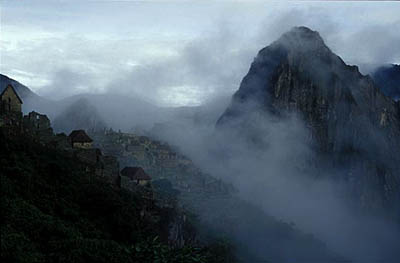
Machu Picchu, the Lost City of the Incas.
Photo: Mylene d'Auriol Stoessel. Machu Picchu Tours & Galapagos Cruises.
Day 12: Machu Picchu - Orient-Express Vistadome - Cuzco
Breakfast. Entrance into the ruins. Day of exploration with your guide or on your own. Start by ascending Machu Picchu for sunrise, which due to the high, surrounding mountains does not occur until around 7:00 am. It takes an hour to walk up to Intipunku (Sun Gate), the end of the Inca Trail and the ancient entrance into the sanctuary. Its majestic panorama of the citadel, seen from on high, is the first view the Incas had upon arriving from Cuzco. Other memorable hikes lead to the top of Huayna Picchu (a strenuous, two-hour round-trip), the Temple of the Moon (a moderate, four-hour round-trip), the Inca Drawbridge (an easy, one-hour round-trip) and Machu Picchu's multitude of hidden nooks and crannies.
A lunch by chef Huaman at the Tampu Restaurant. Descend from Machu Picchu at mid-afternoon and walk to the station for the train departure. Evening arrival at the Poroy Station, on the outskirts of Cuzco, reception and transfer to your hotel. A dinner of inspired dishes influenced by French cuisine and created with local produce of the highest quality by executive chef Federico Ziegler at the Restaurante El Tupay. Overnight in the Orient-Express Monasterio.
Ritual fountains of Tambomachay, Cuzco.
Photo: Mylene d'Auriol Stoessel. Machu Picchu Tours & Galapagos Cruises.
Day 13: Cuzco (Awana Kancha - Inca Monuments)
Breakfast. This morning, see all four species of South American camelid -- the llama, alpaca, vicuña and guanaco -- at Awana Kancha, a living museum of Andean culture. From Awana Kancha, drive to the nearby Inca monuments of Tambomachay, Puka Pukara, Qenqo and Saqsaywaman. Tambomachay is believed to have been dedicated to the worship of water and its aqueducts are fed by springs all year long. The site includes a liturgical fountain and three terraces with structures made from polyhedral blocks of stone, joined without mortar. The setting is bucolic and the spring water is cold, pure and delicious. Drink from the sacred fountain and make your devotions to one of life's essential elements.
Puka Pukara (red fortress) is located at a strategic point along the road to Antisuyo (the jungle quarter of the Inca Empire). It served as a checkpoint and was a military and administrative center. The Inca's retinue received food and lodging here when he stopped at Tambomachay, on his way to the Sacred Valley.
Qenqo is a vast, rocky hilltop carved into staircases, holes and channels, probably built to store the chicha (fermented maize beer) used in Inca rituals. The site features a semi-circular patio studded with several large niches surrounding a stone figure embedded within a chamber, rather like an idol inside its own shrine.
Temple and fortress of Saqsaywaman, Cuzco.
Photo: Mylene d'Auriol Stoessel. Machu Picchu Tours & Galapagos Cruises.
To truly appreciate fortress of Saqsaywaman, one must realize that what may now be seen is only the base of a colossal construction of a series of three successively-higher, defensive structures made from enormous blocks of stone, joined together with great precision.
Inside this triple enclosure, three tall towers were erected on a large narrow ground. The largest of them was called Mayac Marca, which means the round tower. It was built over a clear, abundant spring, fed by underground canalizations, concerning which nobody knew from where or how they came... This round tower contained rooms with gold and silver paneled walls, on which animals, birds, and plants figured in relief, as though in a tapestry. It was here that the king lived when he came for a rest in the fortress...
The two other towers, which were round, not square, in shape, were called Paucar Marca and Sacllac Marca, and were used to house soldiers of the garrison, which was composed only of Incas by privilege, ordinary men, even combatants, not being allowed inside this fortress, which was the house of the Sun, both its arsenal and its temple...
An underground network of passages, which was as vast as the towers themselves, connected them with one another. This was composed of a quantity of streets and alleyways which ran in every direction, and so many doors, all of them identical, that the most experienced men dared not venture into this labyrinth without a guide, consisting of a long thread tied to the first door, which unwound as they advanced....
It would have been in the interest of the Spaniards to maintain this fortress, and even to repair it at their own expense, because, quite alone, it gave proof of the grandeur of their victory and would have served as a witness to it for all eternity. And yet, not only did they not keep it up, but they hastened its ruin, demolishing its hewn stones, in order to construct their own Cuzco homes at less cost.
They made their portals and thresholds with the big flat stones that formed the ceilings, and to make their stairways, they did not hesitate to tear down entire walls, provided they were based on a few stones that could be used for steps.
And so, that is how the Spaniards destroyed the Cuzco fortress.
-- Garcilaso de la Vega, The Royal Commentaries of the Inca, 1609
Campesina at Saqsaywaman, Cuzco.
Photo: Mylene d'Auriol Stoessel. Machu Picchu Tours & Galapagos Cruises.
Saqsaywaman was considered a fortress by the Spaniards, since it was a place of defense, weapons and war. It was considered the House of the Sun by the Incas because, at the same time, it was a place of worship and sacrifice. Notably, it was the site of the most important ceremony of the empire, Inti Raymi, the Festival of the Sun. Its name means "Satiated Hawk" and it was built in approximately 77 years (1431-1508), during the reign of Inca Yupanqui and Wayna Qhapaj. It began being destroyed from 1537 until 1561, becoming the base for the building of the Spanish Cathedral, churches and homes. "Neither the bridge of Segovia, nor the buildings built by Hercules or the Romans, are so worthy of being admired, as this" says the Spanish chronicler and soldier Pedro Sancho de la Hoz, who saw Inca Cuzco intact, along with Pizarro in 1533.
San Blas artisans' quarter, Cuzco.
Photo: Walter H. Wust. Machu Picchu Tours & Galapagos Cruises.
A lunch of traditional Andean cuisine by chef Rodolfo Rolando in the patio of Pacha Papa. Just across the street, visit an artisan's workshop and the Church of San Blas (built in 1562). It houses an imposing pulpit from the late 17th century that, for many, is the finest example of a carved wooden structure in the world. Chiseled from a single cedar trunk, the pulpit features angels, demons, saints, virgins and beasts. A native artist, Juan Thomas Tuirutupa, is believed to have been the sculptor. The main altarpiece is Baroque and exceptionally beautiful.
The Stone of Twelve Angles, Cuzco.
Photo: Mylene d'Auriol Stoessel. Machu Picchu Tours & Galapagos Cruises.
The most renowned of the Peruvian temples,
the pride of the capital, and the wonder of the empire, was at Cuzco,
where, under the munificence of successive sovereigns,
it had become so enriched, that it received the name of Coricancha,
or "the Place of Gold."
-- William H. Prescott, The History of the Conquest of Peru, 1847
Afternoon walking tour in the imperial city of the Incas to their ancient monuments, including the Stone of Twelve Angles, Huacaypata (Leisure Square -- now called the Plaza de Armas and dominated by the Spanish colonial Cathedral). the fine Inca walls of Inti Q'ijllo, the Ajlla Wasi (the House of the Virgins of the Sun) and Qorikancha (the Temple of the Sun). All of these constructions date from the era of 1440 A.D., when Inca Pachakuteq, desiring a capital befitting his great empire, pulled down the adobe city and rebuilt Cuzco in stone.
The Inca palaces were in the form of "canchas", or enclosures, formed by massive stone walls with living quarters, temples and courtyards within. Throughout Cuzco, you will see the Inca walls, built upon by the Spaniards in colonial style. The Cathedral was built over the Inca Wiracocha's palace. The Palacio Arzobispal, or Archbishop's Palace, was erected in the 16th century in an Arabesque style on the walls of Hatunrumiyoc, the palace of Inca Sinchi Roca, which contains the Stone of Twelve Angles. The Church of Santo Domingo (begun in 1534), was built over Qorikancha, the most important religious structure in the Inca Empire. When the earthquake of 1950 collapsed much of the superimposed colonial architecture, it revealed the ancient Temples of the Sun, the Moon, the Stars, Thunder and Lightning, and the Rainbow.
The interior of the temple was the most worthy of admiration. It was literally a mine of gold. On the western wall was emblazoned a representation of the deity, consisting of a human countenance, looking forth from amidst innumerable rays of light, which emanated from it in every direction, in the same manner as the sun is often personified with us. The figure was engraved on a massive plate of gold of enormous dimensions, thickly powdered with emeralds and precious stones. It was so situated in front of the great eastern portal, that the rays of the morning sun fell directly upon it at its rising, lighting up the whole apartment with an effulgence that seemed more than natural, and which was reflected back from the golden ornaments with which the walls and ceiling were everywhere incrusted. Gold, in the figurative language of the people, was "the tears wept by the sun," and every part of the interior of the temple glowed with burnished plates and studs of the precious metal. The cornices, which surrounded the walls of the sanctuary, were of the same costly material; and a broad belt or frieze of gold, let into the stonework, encompassed the whole exterior of the edifice.
Adjoining the principal structure were several chapels of smaller dimensions. One of them was consecrated to the Moon, the deity held next in reverence, as the mother of the Incas. Her effigy was delineated in the same manner as that of the Sun, on a vast plate that nearly covered one side of the apartment. But this plate, as well as all the decorations of the building, was of silver, as suited to the pale, silvery light of the beautiful planet. There were three other chapels, one of which was dedicated to the host of Stars, who formed the bright court of the Sister of the Sun; another was consecrated to his dread ministers of vengeance, the Thunder and the Lightning; and a third, to the Rainbow, whose many-colored arch spanned the walls of the edifice with hues almost as radiant as its own...
All the plate, the ornaments, the utensils of every description, appropriated to the uses of religion, were of gold or silver. Twelve immense vases of the latter metal stood on the floor of the great saloon, filled with grain of the Indian corn; the censers for the perfumes, the ewers which held the water for sacrifice, the pipes which conducted it through subterraneous channels into the buildings, the reservoirs that received it, even the agricultural implements used in the gardens of the temple, were all of the same rich materials. The gardens, like those described, belonging to the royal palaces, sparkled with flowers of gold and silver, and various imitations of the vegetable kingdom. Animals, also, were to be found there --among which the llama, with its golden fleece, was most conspicuous-- executed in the same style, and with a degree of skill, which, in this instance, probably, did not surpass the excellence of the material.
-- William H. Prescott, The History of the Conquest of Peru, 1847

Qorikancha, the Temple
of the Sun, Cuzco.
Photo: Mylene d'Auriol Stoessel. Machu Picchu Tours & Galapagos Cruises.
In the time of the Incas, this garden... was entirely made of gold and silver; and there were similar gardens about all the royal mansions. Here could be seen all sorts of plants, flowers, trees, animals, both small and large, wild and tame, tiny, crawling creatures such as snakes, lizards, and snails, as well as butterflies and birds of every size; each one of these marvels being placed at the spot that best suited the nature of what it represented.
There were a tall corn stalk and another stalk from the grain they call quinoa, as well as other vegetables and fruit trees, the fruits of which were all very faithfully reproduced in gold and silver. There were also, in the house of the Sun, as well as in that of the king, piles of wool made of gold and silver, and large statues of men, women, and children made of the same materials, in addition to storerooms and recipients for storing the grain they called pirua, all of which, together, tended to lend greater splendor and majesty to the house of their god the Sun.
All of these valuable works were made by the goldsmiths attached to the Temple, from the tribute of gold and silver that arrived every year from all the provinces of the Empire, and which was so great that the most modest utensils used in the temple, such as pots and pans, or pitchers, were also made of precious metals. For this reason, the temple and its service quarters were called Coricancha, which means the place of gold.
-- Garcilaso de la Vega, The Royal Commentaries of the Inca, 1609
Return to your hotel.This evening, at the Museo de Arte Precolombino, you will see 450 pre-Inca and Inca masterpieces dating from 1250 B.C. to 1532 A.D. Afterward, dinner of nouvelle Andean cuisine by Manuel Cordova at the Map Café, in the museum's courtyard. Overnight in the Orient-Express Monasterio.
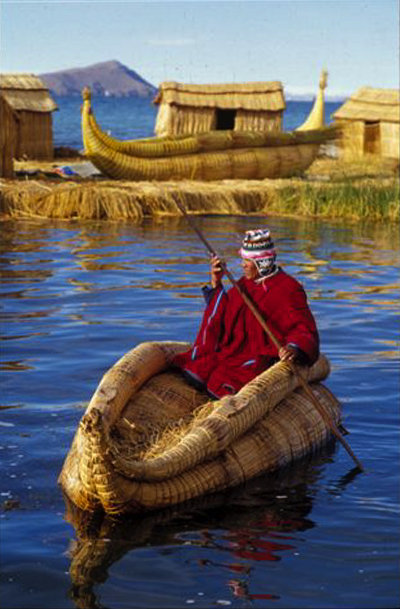
Boatman, Uros Islands, Lake Titicaca.
Photo: Mylene d'Auriol Stoessel. Machu Picchu Tours & Galapagos Cruises.
The worship of the Sun constituted the peculiar care of the Incas,
and was the object of their lavish expenditure.
The most ancient of the many temples dedicated ted to this divinity
was in the Island of Titicaca,
whence the royal founders of the Peruvian line
were said to have proceeded...
-- William H. Prescott, The History of the Conquest of Peru, 1847
Orient-Express Andean Explorer railway, Meseta de Collao, Lake Titicaca.
Photo: Mylene d'Auriol Stoessel. Machu Picchu Tours & Galapagos Cruises.
Day 14: Cuzco - Orient-Express Andean Explorer - Puno
Breakfast. Early transfer to the Orient-Express Andean Explorer. This spectacular rail adventure begins in Cuzco and runs south to the historic city of Puno, on the shores of Lake Titicaca. The gentle climb is breathtaking. The first half of the journey is dominated by magnificent Andean mountains, towering over the deep valleys of the meandering Huatanay River. It then reaches the gentler, rolling Andean Plains, where vicuña and alpaca are often seen. Sightseeing while on board the train is enhanced by a glass-walled observation car. Dining includes a three-course lunch, directed by executive chef Federico Ziegler, followed by coffee served in the observation car. The journey is broken by a scenic stop at La Raya, the highest point on the route.
The banks of Lake Titicaca were the meeting place of three cultures: the Aymara, Quechua and Spanish, the combination of which becomes evident in their artistic and cultural expressions. This unequaled legacy has resulted in Puno being recognized as the Folkloric Capital of Peru.
Festival of Candelaria, Puno, Lake Titicaca.
Photo: Mylene d'Auriol Stoessel. Machu Picchu Tours & Galapagos Cruises.
The city of Puno perches in the southeastern highlands of Peru, or Altiplano, at a breathtaking 12,550 feet above sea level. It is situated on the shores of Titicaca, an ancient inland sea thrust high into the Andes. The area, cold and uninviting by some standards, is rich with spectacular landscapes and imposing archaeological ruins.
Around Puno's main square, or the Plaza de Armas, are the 18th century Cathedral; La Casa del Corregidor, a traditional Puno manor house of the 19th century; and La Casa del Conde de Lemos, a colonial mansion in which, according to tradition, Viceroy Conde de Lemos stayed when he founded the city on November 4, 1668. Early evening arrival, reception and transfer to your hotel. Cocktails, dinner and overnight in the Titilaka.
Chillora, on the shore of Lake Titicaca.
Photo: Mylene d'Auriol Stoessel. Machu Picchu Tours & Galapagos Cruises.
Day 15: Puno (Taquile Island, Sailing & Inka Anatawi)
Breakfast. Morning cruise to Taquile Island to see the living culture of the Incas.
"This is an indigenous community of some 350 families which continues to live within the traditions of the 14th century, according to the principles of Inca life. Here, without noting the passing of time, the three golden rules of the Empire of the Sun have been kept: Ama suwa, Ama quella, Ama llulla (do not steal, don't be idle, and do not lie). The contact with other civilizations has not been able to destroy the profound identity of the Inca way...
On Taquile there are no planes, no trucks, no cars, no motorcycles. It is on foot, following the little pathways of ordered stones, that the visitor allows himself to be infused with this surprising atmosphere that envelops the island. The principal characteristic of the island resides in the fact that it has conserved, across the centuries, a great many of the customs of the old lake population, such as a comunitarian life where everything is shared, exceptional handcrafts, and -- unique of their kind -- dances and traditional music, maintained in all their purity."
-- Hernan Cornejo & Christian Nonis, Rumbos Magazine, Volume II, No. 10, 1997
After a "huatia", a ceremonial lunch baked in an adobe oven, return to the hotel.
Sailing on Lake Titicaca.
Photo: The Andean Experience Co. Machu Picchu Tours & Galapagos Cruises.
An afternoon excursion on a small sailboat with a skilled sailor will let you experience the splendor and spirit of Lake Titicaca, its islands and the Andes. While on board, you can ponder how Titicaca, once an inland sea, was raised more than two miles into the sky by nature's tectonic forces.
Later, ascend an Inca trail to Inka Anatawi, a millennia-old pilgrimage site with a vast panorama of the lake and nearly all of its islands. The Incan ceremonial altars that overlook the immensity of Lake Titicaca still receive offerings for Pachamama (Mother Earth) and Mamacota (Mother Water) from Aymara natives and spiritually-minded visitors. Natural rock sculptures enhance the sacred feeling of this sanctuary, which could well be considered the Gothic cathedral of its age. After descending, visit the local community and see colorful textiles made by its weavers.
Options:
Instead of sailing and Inka Anatawi, you may select an afternoon overland excursion to the poetic pueblos of Juli and Pomata, whose churches are jewels of colonial architecture or to the anciently-carved rockface known as the Puerta de Amaru Muru.
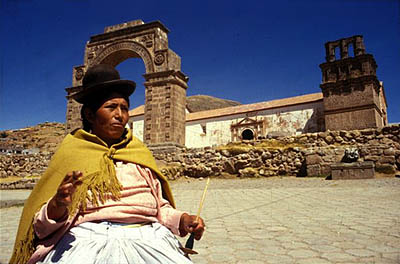
Weaver in front of Juli's Nuestra Senora de la Asuncion, Lake Titicaca.
Photo: Mylene d'Auriol Stoessel. Machu Picchu Tours & Galapagos Cruises.
Afternoon overland excursion to the poetic pueblos of Juli and Pomata, whose churches are jewels of colonial architecture.
Juli, "The Little Rome of America", was once a great cultural and religious center of the Altiplano. In the 17th and 18th centuries, it was occupied by the Dominicans and, later, the Jesuits who, in their zeal to persuade the native population, constructed beautiful churches in the mestizo style: San Pedro, San Juan de Letran, Santa Cruz and La Asuncion, in which are found impressive examples of painting and sculpture in that style.
Pomata, called the "Philosophic Balcony of the Altiplano" because of its sublime geographic location on the banks of Lake Titicaca, is a propitious place for contemplation and inspiration. Its principal attraction, the 17th century, mestizo-style Temple of Santiago Apostol de Pomata is, perhaps, the most beautiful in the south of the country, because of its rich interior decoration, augmented by the architectural expression of its pink granite construction. Beautifully carved pink granite and gold-leaf altars also distinguish the 18th century church of Nuestra Señora del Rosario. Return to the hotel. Cocktails, dinner and overnight in the Titilaka.

Puerta de Amaru Muru, Vilca Uta, Lake Titicaca.
Photo: Edwin Harkness Spina. Machu Picchu Tours & Galapagos Cruises.
Afternoon overland excursion to the anciently carved rockface known as the Puerta de Amaru Muru, one of the most enigmatic sites in the Lake Titicaca region. Some say that the "puerta", or doorway, has magical properties -- that people disappear through it, never to return, and that strange beings have been seen to emerge from it. Some say the doorway is the entrance to the Temple of Illumination of Amuru Muru, one of thirteen lords sent by an advanced race to different parts of the world to preserve their knowledge and sacred artifacts. Some believe that Amuru Muru was the first Inca, Manco Capac, and that he hung one of the artifacts, the Solar Disk, in Cuzco's Temple of the Sun. This disk is said to have been carried back through the doorway centuries later to protect it from the Spaniards. Local inhabitants tell strange stories about the stone doorway, such as it becomes transparent on some sunsets, allowing a view of a city within. Is it really a portal to another dimension of the Universe? You will have a chance to reach your own conclusion. Return to the hotel. Cocktails, dinner and overnight in the Titilaka.
Flamingo on the Uros Islands, Lake Titicaca.
Photo: Mylene d'Auriol Stoessel. Machu Picchu Tours & Galapagos Cruises.
Day 16: Puno (Uros Islands & Sillustani) - Juliaca - Lima
Breakfast. Drive to the Port of Puno for a morning cruise to the Islands of the Uros, forty island-like packs of floating totora reeds. Legend has it that Manco Capac, the first Inca, and Mama Ocllo, his sister-consort, rose from the waters of the lake to found the Inca Empire. The royal pair are said to be the forebears of the Uros, whose descendents now inhabit the lake's famous floating islands. These lake dwellers continue to live like their ancestors did, preserving their customs and idiosyncracies but, above all, their own system of communal life.

Boatman sailing a traditional
reed boat, Uros Islands, Lake Titicaca.
Photo: Mylene d'Auriol Stoessel. Machu Picchu Tours & Galapagos Cruises.
Upon returning to port, begin an overland excursion to Sillustani. Its necropolis, which is one of the largest in America and one of the most impressive in the world, stands over a peninsula-like esplanade, surrounded by the beautiful Umayo lagoon. The chullpas found here are large funerary monuments built by the Collas about 2,000 years ago. These quadrangular and circular buildings are more than 40 feet high and their architectural design is a real challenge for balance, as the diameter of the base is less than the top. The site, surrounded by a landscape that has given rise to diverse and mysterious legends, seems imbued with a magical quality. Picnic lunch among the ruins. Continue to the Juliaca airport for the Flight to Lima. Arrival, reception and transfer to your hotel. This evening, a dinner of artistic cuisine by chef Rafael Osterling at Rafael. Overnight in the Orient-Express Miraflores Park.
House of the Virgins of the Sun, Pachacamac, c. 1500 AD.
Photo: Mylene d'Auriol Stoessel. Machu Picchu Tours & Galapagos Cruises.
Day 17: Lima
Breakfast. Morning drive to Pachacamac, the most reknowned pre-Inca and Inca pilgrimage site of the coast, dating back to 200 AD. It was originally devoted to the worship of the earth god Pachacamac: "he who sustains or gives life to the universe". Upon returning to Lima, lunch at the extraordinary Huaca Pucllana restaurant, located on the grounds of a 1,500-year-old adobe pyramid built by the original inhabitants of Lima. The cuisine is a reinterpretation of the Peruvian Criollo tradition by chef Marilú Madueño (Le Cordon Bleu Paris).
Malecon de la Reserva, above La Costa Verde, Miraflores, Lima.
Photo: Mylene d'Auriol Stoessel. Machu Picchu Tours & Galapagos Cruises.
Afterward, continue to Barranco for a visit to one of the country's finest crafts shops: Mari Solari's Las Pallas. Once Lima's beach resort, this district is now the home of Peru's most prestigious artists and writers. Among its colorful, colonial mansions is the Palacio de Osma, now the Museo de Arte Colonial Pedro de Osma, which focuses on colonial Peruvian art from the country's cultural centers of the day. La Puente de los Suspiros (The Bridge of Sighs) is a romantic outlook over the ocean in the loveliest part of the quarter, said to inspire artists. Next to it is La Iglesia de La Ermita (The Church of the Hermitage), built on the spot where legend has it that a glowing image of Christ appeared to guide sailors home from a tempest at sea. After arrival back at the hotel, have a farewell drink at the bar, order from room service or just rest before the transfer to the airport for your Overnight Flight Home. Relax in the VIP Club while awaiting departure and enjoy a buffet of light fare and beverages, including Peru's famous pisco sour. Day Room in the Orient-Express Miraflores Park.
Day 18: Lima - Home
Flight and arrival home.
© 2013 Inka's Empire Corporation, Machu Picchu Tours & Galapagos Cruises. All rights reserved.
